interview
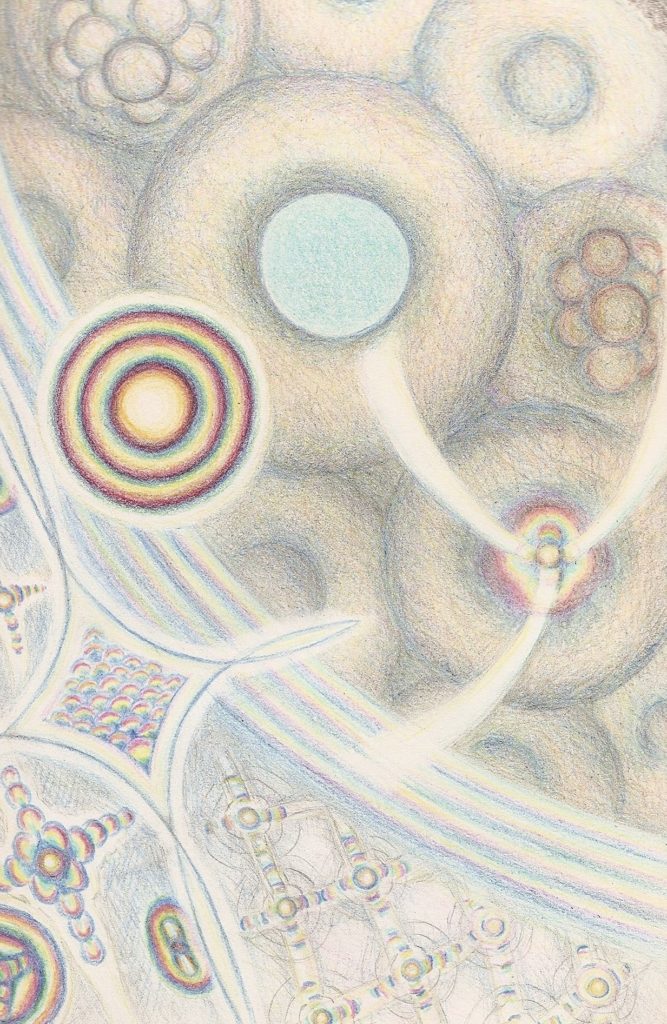
The Path of Joy Interview with Rob and Rachel Olds July 3, 2011 By Jampa Machkenzie Stewart
Jampa: You both were trained as artists, and then lived professionally as artists?
Rachel: Yes, and the hardest part was when we dropped it, when we gave up our careers, [see our conversation with art commentator Suzi Gablik about our decision, “Doin’ Dirt Time, A Conversation with Artists Rachel Dutton and Rob Olds” in Gablik’s book Conversations before the End of Time], and began to wander, because we had no cover identity anymore. It’s a classic mystic’s path, where you drop your identity, and you’re just naked there without any shield, and you just have to trust that letting go. You really drop everything, because the essence of the spiritual path is to let go, to drop away all the elaborations, all the accoutrements, to get to the heart, to the essence of everything.
The artwork was a wonderful way to learn to trust, to allow, to surrender. Then we really had to do it by having no cover as artists anymore, and that was a five-year period. We learned wilderness skills during that time, but our basic identity was already gone before we came to retreat.
Jampa: You mentioned your early inspiration from nature, and also learning wilderness skills. I know that you studied with Tom Brown Jr., who wrote The Tracker. How did that experience help you, later on in your practice of Tögal?
Rob: The Earth is the key to everything, actually. The Earth is the ground on which our spiritual practice evolves. We’re here, now; you can’t do it any other place. To know how to live on the Earth frees you from the fear that modern man has. It frees you from the fear of not having shelter, not having food, not having fire, warmth. These fuel the fears of modern man, because of that ignorance people have; they don’t know how to live on the planet that they were born on.
When you are doing very strict retreat, you need a grounded place, and to be on the Earth in wilderness is the most essential support. So much comes up when you’re doing retreat. Even in the very beginning when you’re sitting and meditating, so much comes up. From the friction of the actual practice, you may feel intense or frustrated. When that happens, you just go out into nature, you go for a walk, or you sit on the Earth; it will absorb it. You feel so comforted. It’s like a womb, it’s a refuge.
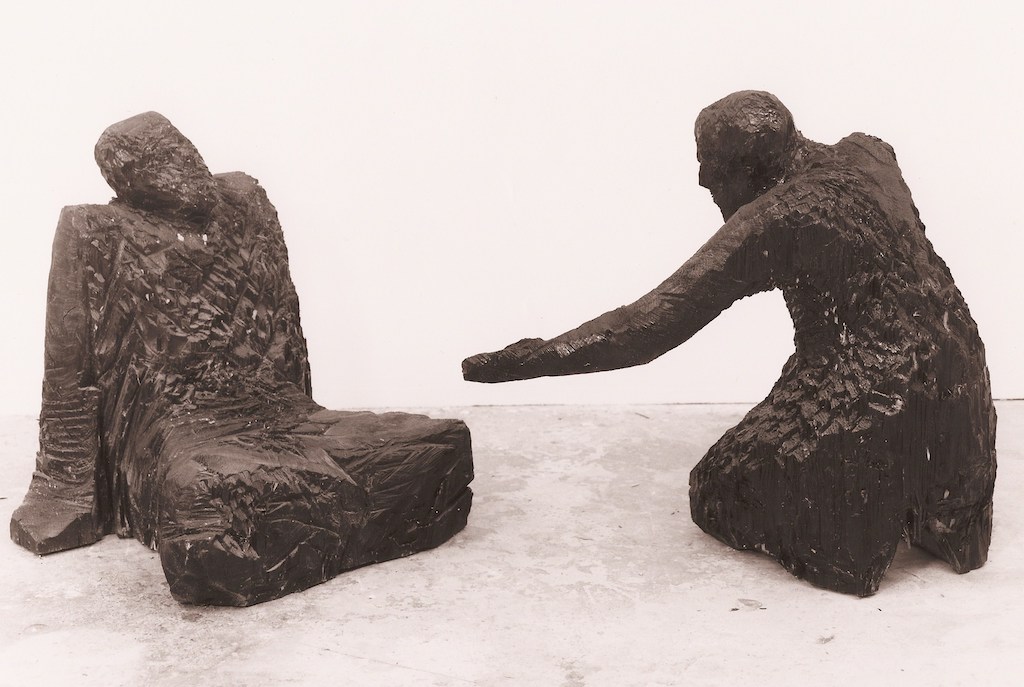
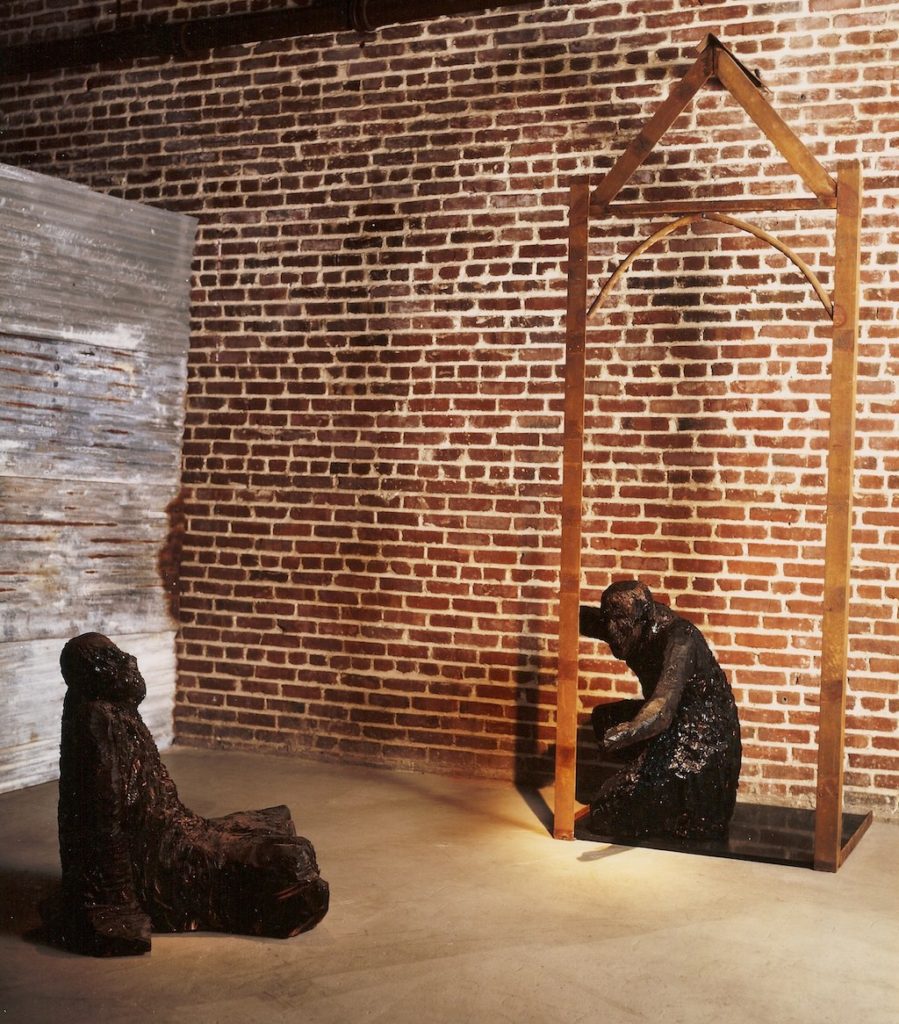
Rachel: If you’re not afraid to be in the wilderness, if you’re not afraid that you might lose your backpack, it gives you a quality of freedom and trust, and you need that for the spiritual path. You need a lot of courage, and trust, and freedom, and you need the nurturing that the Earth offers. If you don’t trust, then you are always guarded, you are always holding, you always have to barricade yourself. If you know how to be directly with the Earth… you may not have to make a fire with a bow drill, you may still have matches, but you know that if you lost the matches you would be okay. Just knowing that was a tremendous help, because the Earth is no longer an alien place; you’re not separate from it to begin with, and because Tögal is the path of union, breaking down all sense of separation, to have already erased that sense of separation from the Earth before we went into retreat was powerful.
Jampa: There are Dzogchen students these days who have received Tögal teachings, and are doing their best to practice in the midst of a city, holding down a job, and taking care of a family. What do you think about that? How are their chances of success in that environment?
Rob: The texts say that when the Tögal visions start to arise, you have to go into retreat, and you drop everything to do it. We’re talking about the last path. This is not just nothing… It’s a sacred demand that comes up. You’re given this incredible chance, in lifetimes.
Rachel: It’s a relationship with living light. It’s living. As the visions begin to blossom from the luminous seed at your heart, it’s literally like a seedling, a little plant. Once the seed has cracked open and it starts to grow, you can’t just say, “I’m not going to water you for the rest of the day.” You and your wife just planted a garden. You now have to take really good care of those little guys for a while. The visions are like that, they’re alive. It’s not a constructed thing you engage in from time to time. It’s a living process that you have invited, and it has accepted your invitation. It’s such a profound joy.
Rob: One of the signs of the first vision, if you’re really in it, is that you do Tögal all the time. This is the last path. You’re blending to the point of essence. You’re letting go of everything, every aspect of your entire being.
Rachel: We had the great blessing to do the practice in retreat, in the wilderness, up in the forest, and we had already let go of everything in our lives before we went in, so we did it under those circumstances. But in the beginning of Tögal, the practice accelerates the naturally molten quality of your experience, and if you’re still engaged with a lot of stuff in the world, that’s all going to start seething, and it’s going to be much harder to drop it because it’s been infused with a lot of life force. I think it’s a real difficulty that people are inviting by doing it that way.
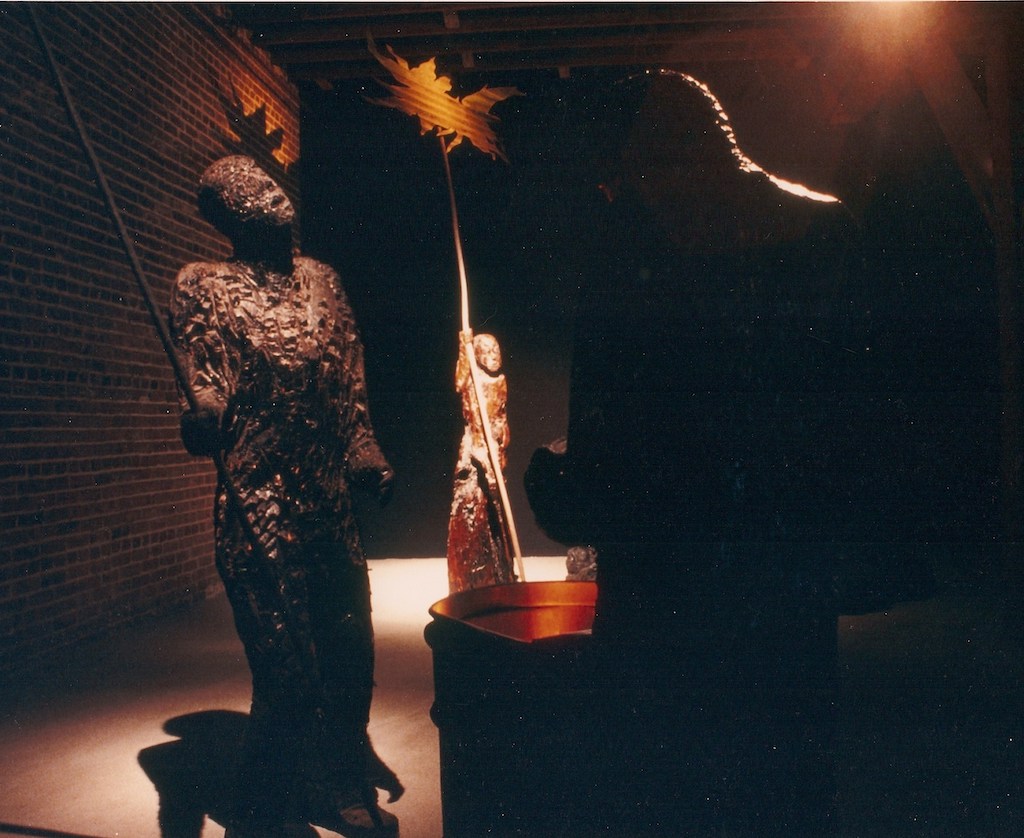
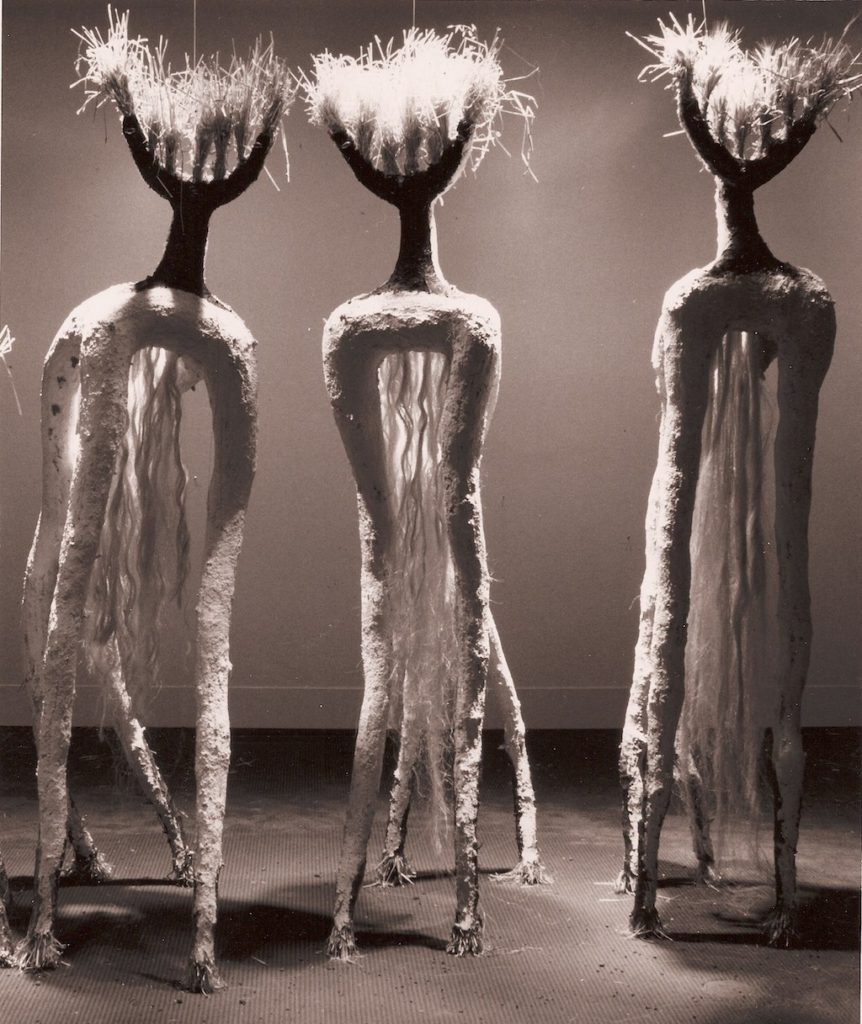
Jampa: You brought up another point, and that’s renunciation. It seems that that is very difficult for most people these days, and from what you’re saying, to practice Tögal you have to give up everything else to allow that experience to arise.
Rachel: The teachings talk about being able to see the visions after death, as a natural part of the bardo, but if you haven’t had any real experience with the visions, if you’re not attuned to them, they’ll probably just whiz by. But they mean it about death. There’s a beautiful passage Rob wrote in one of our books about that. He said that the practice is like pivoting on the point after death, over and over, steadying yourself to recognize the fluid wash of luminous organic being. It’s like that, and so you don’t go into it holding. You have to let go first.
Rob: That’s the key to the spiritual path. If you’re trying to really blend with essence, to let go of all self, you’re not going to be an ordinary person anymore; that whole process, you need to let go into the luminous flow. It’s been offered. Mystics throughout time have done this. In the past it was easier, because there was less to let go of. And there was wilderness. There’s hardly any wilderness left now, that’s not burning, or diseased, or what have you. Most of the wilderness areas in our world are dying. But that’s what it takes, is to let go and enter the wilderness, and let go of self, and let go of all the things that you have, in your mind, your emotions, your paths, all of it. To think that you’re going to have a normal life, and buy a new iPad, and iPod, and do this and do that, it’s a little extreme.
Rachel: You brought up the word renunciation. Renunciation: that’s a big formal word; it has a sense of finality and structure to it. But letting go is about movement, letting go is something you do ongoingly. It becomes a mode of being. You’re always letting go, rather than holding to some state of mind.
Rob: You want to be able to do it as a flowing organic experience of your growth, your spiritual growth.
Jampa: How far along were you in the retreat after having done the preliminary practices? At what point in the retreat were you able to start Tögal?
Rob: When we got the teachings on Tögal about two and a half years into retreat and started to practice, we saw that the visions were already forming. In the texts it says when the visions start to stabilize and the vajra chain starts to slow down, that’s when you totally give yourself to the practice.
And it is such a beautiful moment when you see it. It was just coming home, absolute joy. They tell you it’s the path of joy. It is utterly and completely a joy beyond anything you can even imagine. It’s a path that just brings you gently, takes you by the hand, and effortlessly, step by step, just brings you, and you let go of everything, and then.… essence.
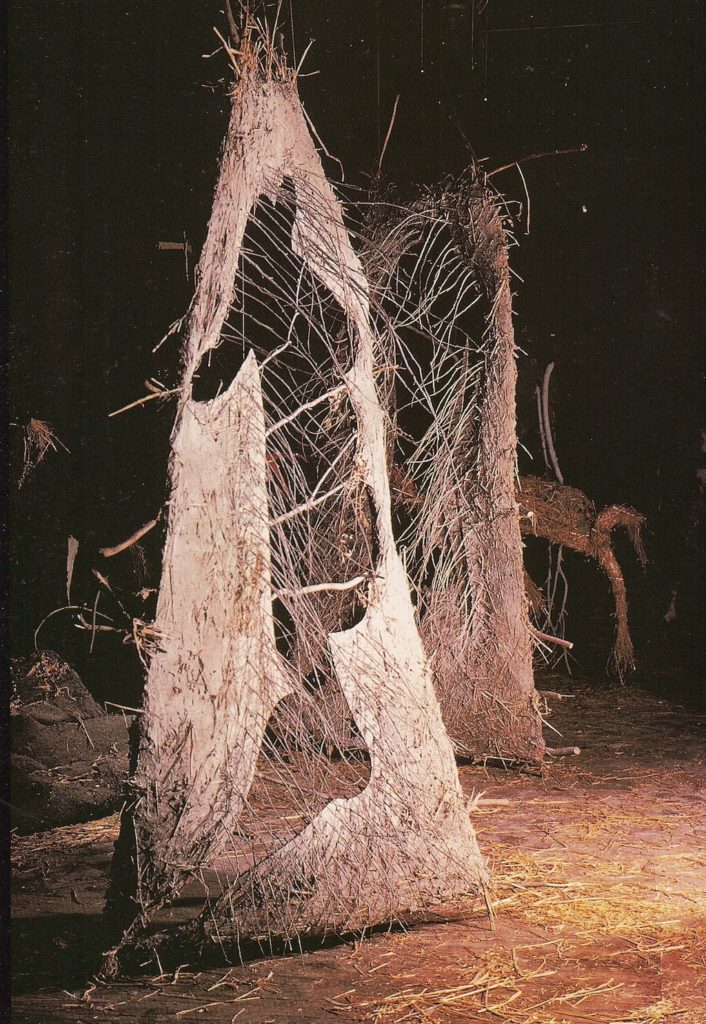
Rachel: And there is no fear; there is no abrupt shift in the whole process. There is just tenderness. It goes so slowly and so gently, that by the time you reach aspects of the third vision, and the whole world is bursting into light, it’s the way things are. You move so slowly that it’s all seamless; there’s no break. It’s a total kindness, a total tenderness of the heart of everything.
Jampa: It sounds like a gentle organic unfolding, the opening of your heart meditates you rather than it…
Rachel: Exactly. You’re not doing, you’re allowing.
Rob: That’s it. You have to have a mind that allows.
Rachel: So that the heart can open. You have to trust the heart, and the mind has to allow that, until it just falls away naturally. And it’s a sense of…we talked about the Earth nurturing: there’s a sense when you’re with the Earth and you trust the Earth, that it’s meeting you in some way, and you really feel that with the visions. The visions are beyond outside and inside, beyond self and other, but there is a quality in the beginning of being met, and being carried.
Rob: It’s not a technique that you do, you’re allowing the embrace of the visions to happen. And it’s happening from your heart, taking you on the last path. Totally extraordinary.
Jampa: Speaking of extraordinary, it’s extraordinary that the two of you as husband and wife, did the retreat together from beginning to end. That’s very unusual from what I’ve heard of retreatants doing Tögal practice. How do you feel that that affected the process of your retreat?
Rob: It was incredibly helpful. It was a blessing, because we had each other to reflect off of. Even before we came to the Gonpa, we couldn’t get stuck in our own meditative habits and ways because we were always together meditating and practicing, long before we came to the retreat. You can’t get into a habit of things. You always have somebody else that does it differently.
Rachel: There are people who are by themselves in retreat and set their boots in exactly the same place on the floor every day. In the absence of all your other contexts, you can build up some very intense habits in retreat. We could never do that.
Tögal is a path of union from the very beginning. It’s a path of meeting the visions. It’s a path of meeting light. It’s a path of meeting to the point of blending. The fact that we were together was part of our path.
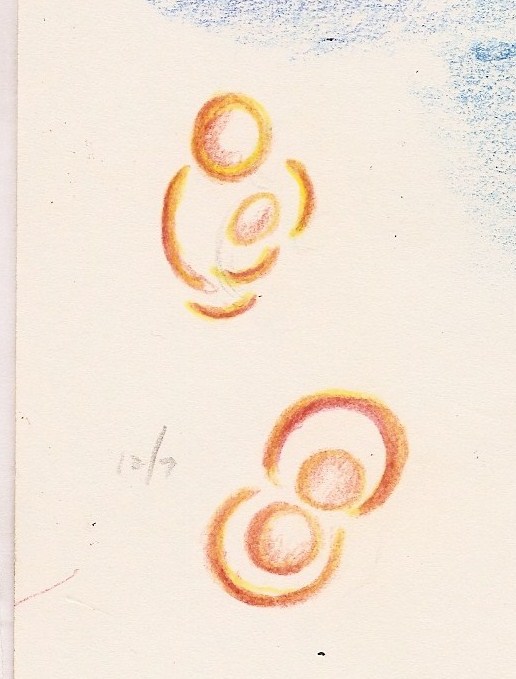
Jampa: Tögal sounds like a path of… there’s a relationship.
Rachel: It is a relationship. It’s reciprocal. You’re allowing it, but there’s really this sense that you’re not alone. You’re part of this huge web of energy. And so the fact that we were part of each other I think enabled us in some way to do it, because we had already shifted out of a quality of separation by being together. We had already bonded. The ability to bond and care is part of the visions, and it’s the energy that forms this entire world vision we find ourselves in. You see it in Indra’s net, in the shimmering lattices of light. That joining, bonding, compassionate, caring energy is the intent of the essence. It’s manifesting this entire vision, so that all beings can reflect home, can go home. There’s a caring and a compassion built into the total fabric of experience.
Rob: And in the drawings we made. In our book of drawings of the Tögal visions there is a section on union. Two spheres come together, and then they blend. It’s like you have two dew drops on a leaf and then they blend together, in a sense that’s what Rob and Rachel are. We’re just two spheres that have blended together to form a union. We each have our own sphere of influence that Rob and Rachel are. But now we’re blended, just like those two dew drops.
Rachel: Blended into essence.
Jampa: This reflects later on in the visions; the holy ones begin to appear, and you see them in union.
Rachel: It’s a union beyond consorts, beyond sexual, beyond even mother and child. It’s the basic energy of bonding and caring. Even now in the field of science, modern biologists are rethinking the theory about competition driving evolution, that it’s actually cooperation that allows life to evolve into more complex forms. They’re reevaluating their whole way of understanding it. We have more caring in us than we are giving ourselves credit for at this moment, at this time in history. It’s part of the makeup of humans to care, interact, and cooperate, but it’s been occluded by a lot of centuries of separation, and structures that are built up to reinforce that. But when we entered the visions, that caring bonding, joining, union quality, that blending, which is a beautiful word for it, that blending aspect of things which is natural to the heart, is just the essence of being.
Jampa: You’re both artists. You did the retreat together, and you both began drawing illustrations of your visions. How did you begin taking visual notes?
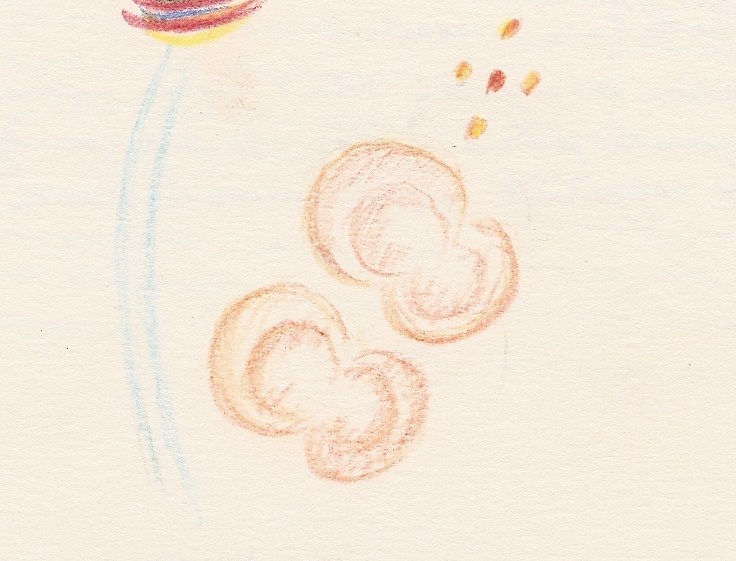
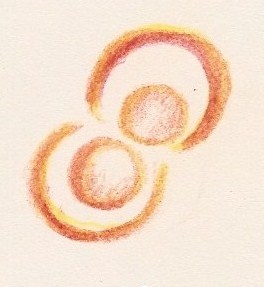
Rob: We were in silence at the beginning of the practice. We would draw little sketches in pencil on pieces of paper and started handing them back and forth to each other. Then we were drawing in sketchbooks. We’re trained as artists; it was so easy to sketch something on a break. You just sketch part of the vision that you had just experienced. It was so natural. And it’s amazing, because Rachel and I have slight differences, in our eyes, and our energetic makeup, and yet the visions were coming out so similar. So within a week or two of each other, new aspects would arise for us.
Jampa: The same things would arise?
Rob: Yes, they were the progressions of the visions as they are supposed to happen, and the signs of the visions were arising for us. Our awareness was also ripening around the same time for each of us.
Rachel: And as artists, the drawings came naturally as part of that ripening process. After a certain point, the Tögal visions and your awareness move as one; they are joined. People usually see the way their culture trains them to see, and as artists trained in both abstract and representational art, we were able to see what was arising and render the details without shaping them in a more traditional cultural idiom.
Jampa: That reminds me of something you said the other night, speaking about the channel that connects the heart to the eyes and bypasses the brain. And that the brain affects and translates the signal from the retina. Can you speak a little on this?
Rachel: We were given a book on eye exercises early in the retreat, and in the back there were footnotes on eye structure. Current research is saying that the retina has an intelligence of its own. It processes the image for color, motion, and outline. It then sends the data to the brain, and the brain processes for distance, dimension, and detail, and adds meaning. The brain augments the image by a factor of six I believe; I can’t remember exactly. And that’s what you are seeing right now.
There is also a lot of information in contemporary culture now about the intelligence of the heart. It’s quite wonderful, because the traditional teachings on Tögal talk about a direct connection between the heart and the eyes. In the Tögal visions the organic quality comes from the intelligence of the heart meeting the intelligence of the retina directly.
For people who are not able to let go of the participation of the brain in various ways, even when the vision does arise, it’s filtered back through there, through the brain, and they are seeing it augmented through that factor of six. By contrast, we were able to see the vision purely, and that’s what we drew. What the retina and the heart see is not culturally conditioned. It doesn’t look like a cultural concept. You’re seeing purely the nature of reality.
You drop a stone in a pond, you see rings of light out across the water. You see rainbow circles in the visions. They’re from the same source.
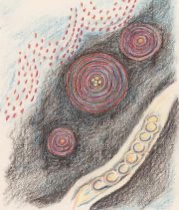
Rob: The Tögal visions are very fluid, just like a pond, When you sit with a slow moving stream or a pond — it has an atmosphere above, and then it has the surface where drops of water can make concentric rings of rainbow light if they’re reflecting off the sun. Then just below, there are other images. You can see leaves floating underneath, or a fish will swim by.
It’s just like that. That’s how the visions are: multilayered and soft in a fluid way. It’s very soft like a pond moving, like the source of water in a pond moving, just very soft. And that quality is such a part of our being in this vision we’re in, this Earth vision that we’re in. There’s a fluidity to it; if you are in the natural world you’ll see it. And that pond is a direct connection to it.
Jampa: Do you feel that it was your background as visual artists that made it easier for you to bypass the brain and go directly into contact with the heart and eyes?
Rachel: Not necessarily, many people may train as visual artists and not bypass the brain.
Rob: But there is a quality of being an artist. When we were doing art, we would do it from a heart perspective. I would sit in my studio and be totally stuck. Nothing was coming, and I would wait. Wait and wait until something arose from my heart and it would burst out of me and I would start making ink paintings, or sculpture, whatever it was. So we allowed it to come.
Rachel: I think spiritual intent is at the heart of it. And I would say the heart… I don’t know if someone necessarily has to be an artist, or visually oriented, but you have to be able to open your heart. Whatever it takes, you need to allow the heart to open. You need to trust the heart to open, and you need to trust the fluidity.
We talk about being caught in “tunnel vision,” “tunnel mind.” Concentrating and focusing on a narrow field are very much a part of our culture. That’s one reason we emphasize wide angle vision in our teachings, which is the natural way for humans to use their eyes — open peripheral vision. You pick up movement; it’s a much more fluid and aware form of vision. A fly will go by in the periphery and it looks enormous! Because movement really reflects. Wide angle vision brings you closer to [direct] retinal vision.
You need the ability to be comfortable with fluidity and uncertainty. We talk a lot about that. That’s why letting go is important. Not so much that you can say, “I had a big pile that I don’t have anymore,” but that you enter a fluidity that’s natural for you, and you trust it.

Rob: For example, native peoples around the world didn’t live with a sense of certainty.
Jampa: That’s an understatement!
Rob: Yet it was not only uncertainty, but grace. It’s a fluid movement, because they knew in their hearts that they would find what they needed. It’s not like when the agrarian revolution happened, and people settled down, and you had to know in a more fixed way, you had to find out how to know and how to repeat it. Pray here, pray now for the rain to come. So many certainties have to come be factored in.
But as a hunter/gatherer, you know the season has changed, and you move beyond where you are, into a basic unknown. But you’re blended with this Earth, so you just move where you need to move. It’s not an uncertainty that is void of grace; it’s alive and fluid, and one with your own heart. That’s what helped us, that fluid grace. Living in uncertainty, that fluid grace of uncertainty…
This modern world is created around certainty, and very solid. As a mystic you have to enter into a fluid way of allowing your heart to open. That is so similar to native peoples in the past, people who were moving in that fluid way. So a vital aspect I think, of coming to Tögal, is to have that quality of allowing, totally allowing, not just in the Tögal practice, but allowing in your whole being.
Jampa: So, now that we have come to this point, can you briefly describe the four visions of Tögal, and how they shift from one to the next?
Rob: The four visions are very similar to how a seed sprouts and grows. The seed is centered into soil that is nurturing and alive. You have to have that background of letting go, of an allowing mind that allows the heart to open. That’s the nurturing soil. The luminous seed within your heart is already there, within all beings, and when you’re ready, it sprouts. The first vision is like a little sprout, like a seedling. The second vision is growth, the seedling grows.
Jampa: First is the direct experience, and the second vision is increasing…

Rob: And then the plant reaches effulgence, blossoming beyond limit, which is the third vision. This is your zucchini plant in midsummer. But then, as all things do, just as our life follows the same pattern, we grow and mature, and then we decline into death. It’s a cyclical process that’s just like a circle. Our website is called acircleisdrawn.org. That’s it. It’s a circle. It’s what you first see in the Tögal visions, and it’s the complete aspect of all that manifests in this world.
The fourth vision is the dissolution. Of the four Tögal visions, it is the most profound, the most meaningful, the most important thing you can do, to experience that fourth vision. You come to the furthest reaches of the effulgence, and then there is a feeling like a wave cresting. And it just goes down, just like a wave on the ocean. If you’ve ever watched waves cresting on the ocean, as they curve down, there’s a point when the wave turns inward and then collapses; that’s where the single sphere is, and then that too resolves. Everything resolves….the exhaustion of all phenomena, where all phenomena resolve. It’s not just a concept. It’s not a metaphor. It actually resolves, and your body resolves. Nothing is there. There is no you, there’s no body, there’s nothing.
But you return to this life, and you have a memory embedded in your being. What comes back is essence. It’s a being-ness that is never gone, whether you’re waking, sleeping, whatever. It’s always there, and that’s what propels you into life again; it is to follow that intent that manifests this world. It’s an intent with a capital ‘I’. It’s not a simple little word. You’re not going to find it in Webster’s. It’s not going to be so clear; that intent is potential manifesting. And it manifests as this natural world, and as the Tögal visions.
Rachel: And you come back seamlessly as a part of it. It all arises again as one fabric, and it’s utterly indelible that there is no separation in anything.
Jampa: And within this fabric is the Bodhicitta, is compassion.
Rachel: The fabric is a vast compassion, beyond words to name it, a vast sea of compassion. It’s the nature of being
Rob: If you blend yourself with the natural world, you come to experience that compassion naturally. It’s a natural aspect of this world. This world offers us everything to live and progress along the path. Everything is offered, and it’s in the same format as the visions. It’s all there. The intent is for us to reflect back to the essence.
Rachel: That cycle of intent, the circle, is the nature of everything: molecules, atoms, dewdrops, eyeballs, galaxies, planets.

Rob: About six months ago we saw that a scientist studying the origins of the universe had made a finding that we haven’t had just one Big Bang; there has been a cyclical series of them. The shape of them, from the picture of the studies, was in exact concentric rings.
Rachel: The cyclical nature of the cosmos is really important to recognize, because we live in an expanding culture that’s linear: we are preoccupied with this linear progression. “More, better, best!” But the nature of all manifestation is cyclical; it will expand and then decline. In the Tögal visions you let the whole expanse of the radiance go, you ride that downward inward flow in the fourth vision into that single sphere, and then everything dissolves.
But in this culture, the decline is coming with great hazard to a lot of people, and to this Earth, because so few have recognized that expansion isn’t indefinite. So few are adjusting to that. Most people are just trying to prop it up.
The reason we shared our drawings in our book of the Tögal visions and talked about the full scope of the cyclical aspects of Tögal and our experience of it is because this is a time of decline, and a lot of people are resisting it.
But it’s also a time of “setting seed.” We want people to know that this is a powerful time for setting seed. You go out in your garden in late summer when the seed heads are starting to form. If you top them off a couple of times, the plant will eventually get exhausted. It needs to make seed. Seed is a natural element of the cyclical aspect of manifestation. The whole expansion goes naturally into the seed. You have an entire oak tree, and a little acorn. The energy that is in a seed is phenomenal, and this is a time for doing this, for setting seed.
In England, people carved images of aspects of the first and second visions on stone outcroppings, 4,000 to 6,000 years ago, during the Neolithic age. They were setting seed, leaving a record of a quality of experience that was about to be lost with the advent of farming and linear mind.
Rob: They were carving with stone on stone, and they made beautiful renderings. It’s an incredible feat in a way, to do that kind of carving: concentric rings, strands of light, and simple unions, stone on stone. It’s a lot of work! It was extremely important to them to represent this experience in this way. And it was not just one person doing this carving, but many people, over several thousand years, and they did them all across England. New sites have been found recently.
Jampa: Is there a website depicting these carvings?
Rob: Yes, http://archaeologydataservice.ac.uk/era/ has photos from the sites in Northumberland, or you can search “rock art in England” on Google images.

Rachel: Look at the first rows of pictures, especially the Barningham Moor and Northumberland sites. They look remarkably like our drawings of the early stages of the Tögal visions.
Rob: That was also a time of great change and decline. Everything is naturally offered by the Earth, but the ancients who carved these images, the elders, the sacred ones who had experienced this path and lived a more fluid way of being, were seeing people settling down, clearing land, and farming. The elders were leaving landmarks to a way of being that was about to be lost.
Jampa: Going from hunter/gatherer…
Rachel: Yes, and that has affected human mind, and the way humans relate to themselves and the world. It’s reinforced separation, and a sense of competitiveness, aggression, all of that. It’s overlaid the compassion that’s at the core of everything as it naturally arises.
Rob: We are in a situation right now where our world is dying. It’s not a metaphor, it’s not a possibility. Scientists are giving us forty years before the whole ocean is dead — devoid of all life.
Jampa: This is in the Huffington Post?
Rob: Yes, and we’re still in this idea of expansion. You can’t think any other way; you have to think big, indefinite expansion. So it’s going to crash. I think some people understand that.
Jampa: Al Gore certainly does.
Rob: So we’re trying to say, “Wake up to this beautiful vision, this Earth, that everyone can touch.” Everyone can touch this vision right now by opening their heart to the natural world and understanding in a heartfelt way that it’s sacred, just as sacred as the Tögal visions. It is a sacred offering that we’re a part of, and we need to honor it. We need to save it for future generations. It allows people the generous nurturing to do this practice, to follow this path. Without it… some might say, “Oh there are plenty of other planets around.” But if a word called “sin” could be used, it would be a total sin to lose an Earth.
Life has manifested like this; it’s so beautiful. When you see a picture of the Earth from space, you know how beautiful… It’s a sphere of water, just like our eyes, that allows the visions to come out. It’s extraordinary. It’s an amazing time right now because we are in the path of dissolution. And within that change you can set the seed of your practice, set the seed of your spiritual growth.

Rachel: Really look at what’s essential in your life, what you really want to have go forward from this moment in time. What future do you want for yourself, what future do you want for all life, all beings. Concentrate on that right now; that’s the setting seed process. This is not the time to encourage more growth, to make more leaves and flowers. This is the time to simplify, to really concentrate on what is utterly important, what is true and essential.
Jampa: Well now I have a clearer idea of what you meant by saying that this is a time of setting seed, because I remember back to my first garden, where I followed these plants sprouting, maturing, and then right after going to seed, they died. I was kind of shocked. But it passed on the seed for later.
Rachel: Seeds are a powerful offering. There’s a sacrifice involved in seeding, a self-sacrifice. The plant gives all of its life force to the seed for another generation, for many generations.
Rob: If you look at a sunflower head and see those spiraling patterns — a head of seeds surrounded by furling yellow petals. It’s a beautiful image of that holiness that the seed is, whether it’s in your heart, or whether it’s in that head of a sunflower. It’s a total expression of grace in our world. And that’s in our hearts; you can see that same expression in the visions.
Jampa: So the visions are really emerging from the heart.
Rachel: They emerge from the heart seed in the same way that this entire natural world emerges; they both emerge from the heart of essence. It’s the same emergence, the same process.
Jampa: You say, “in the same way,” and yet they’re….
Rachel: ….all made out of circles of light!
Jampa: Are they the same?
Rob: They arise in the same way, for the same purpose, but each has a different part, or a different role. The Earth is our mother; you can’t live without it. You have to be nurtured. You grow to a point where you can practice Tögal in an allowing way, and when the visions do arise, it’s just the same process of fluidity, it moves in that same cycle. But it’s the last path, and that last path takes all of the nurturing you can give it. Because you know how you take a stone and toss it into a pond and it makes a concentric ring? By doing Tögal, you are throwing a stone into the universe of space. It goes out to touch all beings, and that is an absolute truth; it does, whether they feel it or not, whether they’re conscious of it or not, it’s felt within the whole universe. It’s so important. It’s the most important thing to do.
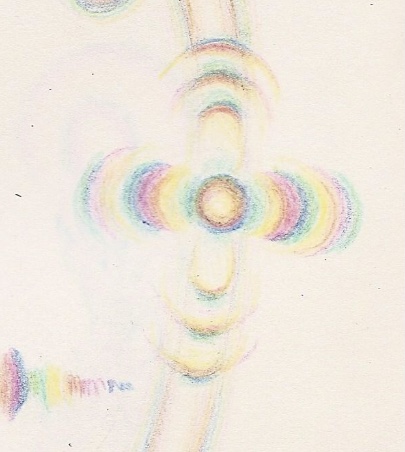
And so, when we see people who are trying to practice Tögal while still having their ordinary lives, driving around and doing things in the world, it’s sad. Because it’s not going to happen.
Rachel: We need more people experiencing the visions directly.
Rob: From the heart, allowing it to happen.
Rachel: The full process, to really go through the fourth vision. The third vision is in some ways easy, because expansion is something people are used to. “This is a rush, it gets bigger, more beautiful,” etc… but to let it go, to let it actually resolve into that inward expansion, the single sphere, and then let it all go: that’s the offering. That’s the real offering. That’s the ripple that goes out. When you let it go.
Rob: And you’ve got to let it go. If people are holding, they’ve got to let it go. And it’s a sadness when they don’t.
Jampa: So at this period of time, it seems to be what’s prophesied as “the degenerate times.”
Rachel: Yes. Although in some ways “degenerate” is an inaccurate term. While our culture is clearly aberrant in many ways, the cycle of decline is not. Just as fruition is a natural aspect of the fabric of being, so are decline and setting seed.
Rob: There are certainly a lot of signs. It’s time for more of a Dzogchen perspective for sure. The seed is one’s own practice.
Rachel: And how ever far you get in this life is the seed that will move you forward.
Rob: And the word — intent… If you set the seed of your practice, it’s an intent that you place on your sphere of being, and when you enter into a new life, it resonates that way towards that end. If you understand or have any experience with spirits who get lost, they get lost for numerous reasons, but the fear and shock of death hit them and they get stuck. It’s that fear, that anger; that’s the intent, the force that propels them into that unfortunate boxed-in projection. But if your setting seed is to be in the intent that will propel you towards Tögal again, if you’re not quite there, if you heart is open, if your mind is allowing, it’s like an intent. If you give it all you’ve got, that’s what it takes to do the spiritual path; you have to give it all you have. And if you die… I almost died twice during the Tögal retreat. I didn’t have a problem with it, but I wanted to finish, and I knew I would be propelled toward it again. That’s what setting seed is going to do. If you can’t finish it, if you can’t do it all, it will propel you into the spiritual life again.
Jampa: And as you said, that seed, that intent, reverberates out into the entire universe, and so aside from yourself, you’re putting that out to the universe as a counter-harmony, or counter-balance.
Rachel: It’s very telling that in our times, one of the biggest dangers we face is nuclear energy, because the center of a bomb is a perfect sphere, the pit; it’s a single sphere that implodes. And there is another danger we’re facing, which is genetic engineering, which is literally changing the seeds of life from an expansionist standpoint. It’s also a time when there’s the process of returning to the sphere of essence… We see the unowned, unrecognized aspects of that potential, as part of the cataclysmic aspects of our time of decline culturally. And so to be blended into essence through the resolution of the luminous single sphere of the fourth vision, is a counter balance to that other kind of sphere.